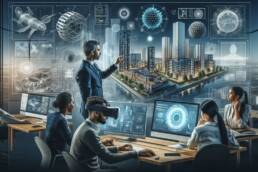3D architectural visualization has revolutionized the real estate development industry by providing a vivid and immersive experience of proposed projects before they are physically constructed. CG Viz Studio, with its expertise in creating detailed and photorealistic 3D images and animations, has emerged as a leader in this transformative technology. This article delves into the myriad ways in which 3D visualization impacts real estate development, from enhancing client presentations to accelerating the sales process.
Key Takeaways
- 3D architectural visualization significantly improves client understanding and engagement, leading to more informed decision-making and increased interest in projects.
- Photorealistic renders serve as powerful marketing tools, providing a competitive edge in attracting investors, buyers, and enhancing digital marketing strategies.
- The technology offers cost and time efficiency by streamlining the design approval process, reducing the need for physical models, and enabling virtual prototyping.
- Interactive virtual tours and detailed previews provided by 3D visualization aid in pre-selling properties and boosting sales conversion rates.
- Future trends in 3D visualization, such as advancements in VR and AR, are set to further revolutionize the industry, emphasizing sustainability and innovation in design visualization.
The Transformative Power of 3D Architectural Visualization
1. Revolutionizing Client Presentations
We’ve witnessed a paradigm shift in how we present architectural projects to our clients, thanks to the advent of 3D architectural visualization. Our presentations have become more immersive and impactful by providing detailed visuals of various materials in a property, showcasing day and night renders, and creating 3D landscape models. This level of detail not only creates a lasting impression but also boosts clients’ confidence and trust in our professional capabilities.
In our experience, the benefits of 3D visualization for architects and real estate developers are manifold. Here’s a list of key reasons why this technology has become indispensable:
- Enhancing communication with clients
- Enabling enhanced property presentation
- Allowing for more creativity and experimentation
- Streamlining the design approval process
We’ve found that effective communication is key in interior design, and 3D interior rendering has transformed how we interact with our clients. With lifelike renders, clients can immediately grasp how their space will look and feel, managing expectations and significantly reducing the need for changes during the construction phase.
Moreover, the feedback we’ve received from clients has been overwhelmingly positive. They appreciate the ability to see and understand the project in a way that traditional 2D drawings simply cannot convey. It’s clear that 3D architectural visualization is not just a tool for us; it’s a transformative force in the way we conduct our business and engage with our clients.
2. Facilitating Pre-Construction Visualization
We understand the pivotal role that 3D architectural visualization plays in pre-construction phases. By creating detailed renders, we offer clients a glimpse into the future of their investments, transforming real estate development and marketing. This early engagement is not just about aesthetics; it’s a strategic move that aids in design validation and provides immersive experiences.
Our expertise in 3D visualization allows for a seamless integration with project management tools, offering a clear roadmap for construction teams and stakeholders. This proactive approach helps in anticipating challenges and streamlining the planning process.
The benefits of facilitating pre-construction visualization include:
- Enhanced visualization for potential buyers
- Informed decision-making with realistic representations
- A marketing advantage with high-quality 3D renders
CG Viz Studio showcases the power of pre-built visuals and evolving technology, ensuring that every project we undertake is not only visually compelling but also strategically positioned for success.
3. Enhancing Collaborative Design Processes
We’ve witnessed firsthand how 3D visualization enhances collaboration among stakeholders in real estate development. By providing a shared, detailed view of architectural projects before construction begins, we ensure that everyone from architects to clients is on the same page. This shared understanding is crucial for making informed decisions and fostering a collaborative environment.
Communication is the cornerstone of any successful project, and 3D renders serve as a powerful tool in this regard. They allow for quick iterations based on feedback, which streamlines the design process significantly. Here’s how we’ve improved our workflow with 3D visualization:
- Rapid prototyping of design concepts
- Immediate visual feedback for design changes
- Clear and effective client presentations
- Synchronized understanding across all teams
By integrating 3D visualization into our workflow, we’ve not only saved time and costs but also improved client satisfaction. The ability to revise and refine designs swiftly leads to a more efficient approval process and ultimately, a better end product.
Emerging technologies are now intersecting with 3D visualization, opening up new possibilities for innovation in our design processes. We’re excited to explore these advancements and continue to revolutionize how we communicate and collaborate in the realm of real estate development.
Strategic Marketing with Photorealistic Renders
1. Capturing the Essence of Future Projects
We understand the importance of conveying the full potential of a real estate development before it comes to life. Photorealistic renders serve as a powerful tool, allowing us to capture the essence of future projects and present them in their best light. By meticulously crafting each visual element, from lighting to textures, we ensure that the envisioned space is communicated effectively and attractively.
Client engagement is significantly enhanced when they can visualize the result. Our approach involves:
- Utilizing cutting-edge software to create detailed and immersive renders.
- Incorporating feedback to refine the visual narrative of the project.
- Showcasing the vision behind the development, emphasizing unique features.
We strive to create a visual experience that not only reflects the architectural intent but also resonates with the emotions and aspirations of potential clients and investors.
The impact of these visualizations is evident in the feedback we receive. Clients are often more confident and excited about the projects, which translates into a smoother approval process and increased interest from buyers. Our commitment to quality and attention to detail in 3D architectural visualization sets the stage for successful real estate ventures.
2. Leveraging Visuals in Digital Marketing
In our quest to redefine real estate marketing, we’ve embraced the power of 3D architectural visualization to captivate potential buyers and investors. By integrating advanced 3D renderings into our digital marketing strategies, we’ve seen a significant uptick in engagement and interest. These renderings not only showcase properties in their best light but also provide a sense of realism that static images simply cannot match.
Our digital campaigns now feature immersive virtual tours and animations that allow clients to experience spaces before they even exist. This level of interactivity has revolutionized the way we present future projects, making it easier for clients to connect emotionally with a property.
To illustrate the impact, consider the following data from our recent campaigns:
- Increased website traffic by 25% due to interactive 3D content
- Boosted social media engagement by 40% with the use of virtual tours
- Achieved a 30% higher click-through rate on listings featuring 3D visuals
These figures underscore the transformative role of 3D visualization in real estate marketing, proving that it’s not just a tool for presentation, but a robust driver of sales and client satisfaction.
3. Attracting Investors and Buyers with High-Quality Imagery
We understand the pivotal role of high-quality imagery in attracting investors and buyers in the real estate market. Photorealistic renders serve as a powerful tool, not only showcasing a property’s potential but also igniting clients’ imagination. These visuals are more than mere representations; they are a form of communication that bridges the gap between conceptual designs and tangible experiences.
- Enhanced Visualization: Potential buyers can explore every aspect of a property, even before construction begins.
- Informed Decision-Making: Clients can make more informed decisions, reducing doubts and uncertainties.
- Marketing Advantage: High-quality 3D renders are utilized across various platforms, enhancing the property’s appeal.
By providing a realistic representation of the final product, we enable clients to fully grasp the essence of their future investment. This early visualization can significantly increase interest and engagement, turning prospects into committed buyers.
Our experience has shown that quality visuals are essential marketing tools that can attract more buyers, generate more leads, and potentially sell properties faster. We strive to capture the essence of future projects, ensuring that every render reflects the vision and quality of the development.
Cost and Time Efficiency in Real Estate Development
1. Streamlining the Design Approval Process
We’ve embraced the transformative potential of 3D architectural visualization to expedite the design approval process. By presenting interactive 3D models, we enable clients to grasp the intricacies of a project with unprecedented clarity. This improves communication and fosters collaboration, allowing for rapid iterations based on client feedback.
- Clear Communication: Utilize 3D renders to initiate discussions, ensuring clients fully comprehend the visual information.
- Efficient Project Management: Integrate feedback loops and revision phases into the project timeline, facilitated by 3D renderings.
- Identification of Flaws: Early detection of design issues through detailed visualization, preventing costly post-construction corrections.
The ability to visualize every aspect of a project before construction begins not only enhances efficiency but also significantly reduces the likelihood of expensive errors. Our approach to 3D visualization streamlines design approval, improves communication, and fosters collaboration for accurate and efficient construction planning.
2. Reducing the Need for Physical Models
In our journey to enhance the efficiency of real estate development, we’ve embraced the power of 3D architectural visualization to significantly reduce the reliance on physical models. This shift not only represents a leap in technological adoption but also a strategic move towards cost management and reduction. By employing architectural visualization, we’ve been able to reduce unforeseen expenses by up to 20% on several projects, ensuring they remain within budget.
The benefits extend beyond mere cost savings. The precision and flexibility offered by 3D models allow for a more dynamic design process. We can now explore different space utilization ideas and optimize the use of space, creating functional and aesthetically pleasing designs. This is particularly evident when addressing spatial challenges early in the design process, which is crucial for project success.
Our commitment to innovation is reflected in the way we’ve integrated high-end 3D visualization services into our workflow. These services not only offer immersive visual experiences but also streamline design processes, attract buyers, and reduce costs and risks.
Furthermore, the feedback we’ve received from clients has been overwhelmingly positive. They appreciate the ability to see every detail of a project before construction begins, which builds confidence and facilitates better decision-making. Here’s a snapshot of the impact 3D visualization has had on our projects:
- Improved communication with clients
- Enhanced design accuracy and efficiency
- Identification of design flaws before construction
- Streamlined approval processes
- Effective marketing and pre-sales strategies
As we continue to harness the capabilities of 3D visualization, we remain excited about the future possibilities it holds for the real estate development industry.
3. Accelerating Project Timelines with Virtual Prototyping
We’ve witnessed firsthand the remarkable efficiency that virtual prototyping brings to real estate development. By creating detailed 3D models, we can explore various design options and make informed decisions before any physical construction begins. This proactive approach not only saves time but also significantly reduces the risk of costly errors and rework.
The use of virtual prototyping has been a game-changer in our ability to meet tight deadlines and manage budgets effectively.
For instance, consider a recent commercial office space project we undertook. The challenge was a tight timeline and budget, with little room for error. Thanks to 3D architectural rendering, we could quickly experiment with different layouts, ensuring the most efficient use of space and resources. The outcome was a project completed on time and within budget, with the 3D renders playing a crucial role in avoiding mid-construction changes.
Here’s how virtual prototyping has streamlined our workflow:
- Facilitating better project planning and management by integrating 3D floor plans with project management tools.
- Improving design accuracy and efficiency, allowing us to see every detail before construction.
- Streamlining the design process by quickly adjusting designs based on client feedback.
By embracing these practices, we’re not just keeping pace; we’re setting new standards in the industry. The impact of artificial intelligence on the real estate sector is undeniable, and as we continue to harness these technologies, we’re transforming the property buying, selling, and management landscape.
Client Engagement and Sales Conversion
1. Interactive Virtual Tours as a Sales Tool
We’ve embraced the power of interactive virtual tours to revolutionize the way we engage with clients and convert interest into sales. Virtual tours and 360-degree views have become indispensable in our arsenal, allowing potential buyers to explore properties at their leisure, from anywhere in the world. This immersive experience is not just about viewing spaces; it’s about feeling present within them, even from a distance.
By providing a comprehensive understanding of a property’s layout and features, we’re seeing a tangible increase in client engagement and sales conversions.
Our data echoes industry research, showing that listings with virtual tours are significantly more likely to sell—and sell faster—than those without. Here’s a snapshot of the impact:
- Listings with virtual tours are 87% more likely to sell.
- Properties with virtual tours sell 10% faster on average.
These figures aren’t just impressive; they’re transformative for our clients and our business. The convenience of virtual tours is especially appealing to out-of-town buyers or those with busy schedules, as it enables them to conduct preliminary assessments without the need for physical visits. We’re committed to leveraging this technology to its fullest potential, ensuring every client can vividly imagine their life in their new home before setting foot inside.
2. Building Confidence with Detailed Previews
We understand the hidden advantage of real estate success lies in the ability to build confidence among clients. This level of visual precision pays off. By offering detailed previews through 3D architectural visualization, we enable buyers to picture the finished product, fostering informed decision-making with confidence. Miscommunication is greatly reduced, as every nuance of the design is conveyed with clarity.
Our approach to enhancing client confidence involves several key steps:
Providing immersive presentations with detailed visuals of materials and landscapes.
Showcasing day and night renders to capture the full ambiance of the property.
Creating lifelike 3D models that allow clients to explore every angle of the proposed design.
These methods have proven to be invaluable in securing early investments and pre-sales for properties still under construction. By integrating case studies and testimonials into our presentations, we further solidify the trust in our expertise and the quality of our work.
3. The Role of 3D Visualization in Pre-Selling Properties
We’ve witnessed a surge in pre-sales thanks to the impact of 3D visualization. By offering potential buyers a glimpse into the future, we enable them to connect emotionally with a space that doesn’t yet exist. This connection is not just visual; it’s a promise of what’s to come, making it a potent tool for pre-selling properties.
The ability to present projects in a visually captivating and interactive manner fosters stronger client engagement, leading to increased interest and investment in the proposed developments.
Here’s how 3D visualization enhances the pre-selling process:
- Enhanced Visualization: Clients can explore every aspect of a property, even before the first brick is laid.
- Informed Decision-Making: Realistic representations help reduce doubts and uncertainties.
- Marketing Advantage: High-quality 3D renders can be showcased across various platforms, significantly boosting marketing efforts.
Ultimately, the role of 3D visualization in pre-selling is to build confidence and excitement, paving the way for successful real estate transactions.
Future Trends in 3D Visualization Technology
1. Advancements in Virtual and Augmented Reality
We are witnessing a significant leap in the capabilities of virtual and augmented reality (VR and AR) technologies within the realm of architectural visualization. These advancements are not just enhancing the immersive experience but are also streamlining the design and decision-making processes. For instance, VR allows clients and stakeholders to ‘walk’ through a virtual model of their project, providing a sense of scale and spatial awareness that flat renderings cannot convey.
Artificial intelligence (AI) is increasingly being integrated with VR and AR to improve the efficiency and accuracy of these simulations. AI algorithms can automate complex tasks, such as lighting calculations and material selection, which results in designs with unprecedented speed and accuracy. Here are some illustrative examples of AI-driven VR software:
- AI-assisted design optimization
- Real-time lighting and acoustics simulation
- Automated material and texture generation
By embracing these technologies, we are able to offer our clients a more comprehensive and engaging design experience. The feedback loop is significantly shortened as changes can be visualized and assessed in real-time, which in turn accelerates the overall project timeline.
CG Viz Studio is at the forefront of this technological revolution, offering high-end 3D visualization services that leverage VR and AR to revolutionize design and marketing in real estate development. The impact of these technologies on our industry is profound, and we are committed to exploring their full potential to deliver exceptional value to our clients.
2. The Growing Importance of Sustainability in Visualizations
As we embrace the future of 3D architectural visualization, we recognize the growing emphasis on sustainability. Incorporating eco-friendly practices into our visualizations is not just a trend; it’s a commitment to responsible design. By simulating various sustainable materials and energy-efficient solutions, we can make informed decisions that positively impact the environment before construction begins.
Italics are used to highlight the importance of sustainability in our work. We’re not just creating images; we’re crafting a vision for a greener future. This shift towards sustainable visualization is evident in the following ways:
- Experimentation with different sustainable materials and technologies
- Optimization of natural light and energy consumption through strategic design
- Visualization of green spaces and integration with the natural environment
Our goal is to ensure that every project we visualize not only meets aesthetic and functional requirements but also aligns with the principles of sustainability. This approach is crucial for achieving certifications like LEED and for the long-term well-being of our communities.
3. Anticipating the Next Wave of 3D Visualization Tools
As we embrace the future, we anticipate a new wave of tools in 3D architectural visualization that will further revolutionize the industry. The integration of advanced technologies will redefine how we interact with and conceive architectural spaces.
Emerging tools are expected to offer even greater interactivity and real-time rendering capabilities. Here’s a glimpse into what we can expect:
- Enhanced virtual and augmented reality experiences
- AI-driven design assistance for optimized workflows
- Eco-conscious visualization features promoting sustainability
These innovations will not only streamline the creative process but also open up new possibilities for client engagement and project visualization.
We remain committed to staying at the forefront of these developments, ensuring that our clients benefit from the most cutting-edge solutions available. The goal is to provide immersive experiences that give a competitive edge in the industry, enhancing design, marketing, and sales.
As we look towards the horizon of technological innovation, 3D visualization stands at the forefront, promising to revolutionize the way we interact with digital content. The future trends in this field are poised to enhance realism, interactivity, and accessibility, making immersive experiences more prevalent across various industries. To stay ahead of the curve and harness the full potential of these advancements, visit CG Viz Studio. Our team of experts is dedicated to providing high-end 3D visualization services that bring your visions to life. Explore our portfolio and discover how we can elevate your projects to the next level. Don’t just imagine the future; visualize it with us today!
Get your project estimated within 60 minutes - simply send us your project brief!
Conclusion
In conclusion, 3D architectural visualization has revolutionized the real estate development industry by providing an immersive and detailed preview of architectural projects. Companies like CG Viz Studio have exemplified the power of this technology through their high-quality renderings and animations, which have garnered exceptional reviews from clients worldwide. The ability to visualize spaces before they are built has not only improved marketing strategies and client engagement but also facilitated better decision-making and project understanding. As we look to the future, the continued innovation and adoption of 3D visualization are set to further enhance the efficiency and appeal of real estate development, making it an indispensable tool for architects, developers, and marketers alike.
Frequently Asked Questions
3D Architectural Visualization is the process of creating digital models of buildings or spaces before they are constructed, using advanced software to generate highly realistic images or animations that depict the future project from various perspectives.
3D Visualization significantly impacts real estate development by enhancing client presentations, facilitating pre-construction visualization, improving collaborative design processes, and serving as a powerful marketing tool to attract investors and buyers.
CG Viz Studio offers services including 3D Architectural Visualization, 3D Renderings, 3D Animations, CAD 3D Modeling, 3D Interior and Exterior Visualization, and more, catering to architects, real estate developers, and marketers.
3D renders provide a photorealistic representation of future projects, capturing their essence and enabling marketers to leverage visuals in digital marketing campaigns, which helps in attracting investors and buyers with high-quality imagery.
Yes, 3D Visualization can accelerate project timelines by streamlining the design approval process, reducing the need for physical models, and allowing for virtual prototyping, which saves both time and resources.
Future trends in 3D Visualization technology include advancements in virtual and augmented reality, a growing emphasis on sustainability in visualizations, and the development of new tools that will further enhance the capabilities of 3D Visualization.



